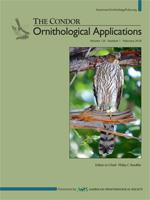The potential for wind energy facilities to affect species of grouse in the grasslands of the Great Plains of North America is a conservation concern. Communication by male Greater Prairie-Chickens (Tympanuchus cupido pinnatus) is essential for lek mating displays and includes low-frequency vocalizations that could be disrupted by wind turbine noise. We studied the effects of wind turbine noise on the boom, cackle, whine, and whoop vocalizations of male Greater Prairie-Chickens recorded at 14 leks located 703 m to 23 km away from a wind energy facility near Ainsworth, Brown County, Nebraska, USA, in 2013 and 2014. First, we assessed ambient sound levels at our study sites. Wind turbine noise contributed to the soundscape; leks <1,000 m from wind turbines had higher levels of ambient sound than expected on the basis of recordings obtained at remote locations. Our second objective was to determine whether the acoustic characteristics of the 4 vocalizations recorded near the wind energy facility differed from those recorded farther away. At leks within 1,000 m of the wind energy facility, boom and whoop sound pressure levels were higher (boom 2% higher; whoop 5% higher), boom duration was 3% shorter, whine fundamental frequency was 11% higher, and biphonations in cackle vocalizations occurred 15% less often. These differences suggest that male Greater Prairie-Chickens adjust the acoustic properties of their vocalizations in response to the sounds generated by turbines at wind energy facilities. The effect of the adjustments reported here on the mating success of males near wind energy facilities remains to be determined.
How to translate text using browser tools
10 January 2018
Male Greater Prairie-Chickens adjust their vocalizations in the presence of wind turbine noise
Cara E. Whalen,
Mary Bomberger Brown,
JoAnn McGee,
Larkin A. Powell,
Edward J. Walsh
ACCESS THE FULL ARTICLE

The Condor
Vol. 120 • No. 1
February 2018
Vol. 120 • No. 1
February 2018




